�
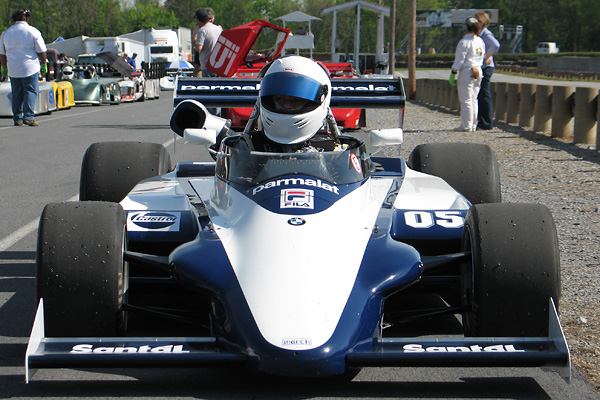
�
Justin Frick's 1982 March 822 Formula Two Racecar
� � Owner: Justin Frick� City: Lewisbury Pennsylvania
� Model: 1982 March 822
� Engine: BMW M12/7 2.0L four-cylinder
� Restored and race prepared by: owner�
�
March Engineering Ltd. Was Most Successful in Formula Two
��
The management of March Engineering Limited wanted it all. They wanted to field works race�
teams in Formula One, Two, and Three. Simultaneously, they wanted to produce and sell a�
full range of "customer cars" for these classes and for many others. It's difficult�
to assess March's success because the scope of their efforts was very broad.�
�
On the one hand, March produced 66 Formula One cars between 1969 and 1989. All those cars taken�
together only scored three Formula One championship race victories. March was far more successful�
in Formula Two, where they produced 327 cars which won countless races. Arguably, the Golden Age�
of March Engineering was 1971 through 1982. In that period, March Formula Two cars delivered six�
FIA Formula Two World Championships: 1971 with Ronnie Peterson, 1973 with Jean-Pierre Jarier,�
1974 with Patrick Depailler, 1978 with Bruno Giacomelli and the Polifac team, 1979 with Marc Surer�
and the Polifac team, and 1982 with Corrado Fabi.¹�
�
March typically produced an all-new Formula Two chassis design every several years. They made�
evolutionary and developmental refinements in in-between years. For 1979, March's 792 model�
was a "ground effects" car, with shaped tunnels under the sidepods and with sliding skirts to seal�
the car well enough to the racetrack that a significant vacuum could be developed at speed.�
The 792 model also featured a new, narrow, aluminum monocoque tub reinforced with honeycomb inserts.�
A single radiator was mounted inside a chisel shaped nose, with narrow wings to either side.�
The 792's inboard front suspension had rocker arms on top and ordinary wishbones below. For the�
802 model, bodywork was modernized substantially. The 802 featured a pointy nose and dual venturi-type�
radiator sidepods. Side skirts were installed at a fixed height to meet new rules. For the 812 model,�
March introduced another new monocoque tub and body. Starting with the 812, the rear suspension was of�
rocker type too. The 822 was a development of the 812, but with a slightly narrower tub, refined�
aerodynamics, and further improvements to the rear suspension geometry. �
�
By every measure, the 822 model was brilliantly successful. Thirteen examples were built.�
March's works team drivers finished first and second place in 1982 Formula Two Championship�
points while racking up eight wins in thirteen races. �
�
Throughout this whole era, March produced variants of their Formula Two cars for export to North�
America. For the North American market, these racecars could be ordered at two different specification�
levels, suitably equipped for racing in Formula B or Formula Atlantic classes respectively. �
�
�
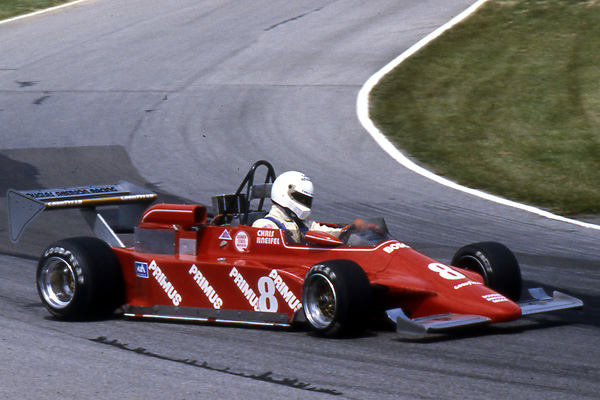
�
Chris Kneifel driving March 82A-4 for Douglas Shierson Racing in 1982.
�
(Photo by Mark Windecker. Used by permission.)
�
 �
�
�
�
March in Formula Atlantic
��
Through the late 1970s and into the 1980s, Formula Atlantic cars and Formula Two cars were�
very similar. The key difference was that Formula Atlantic rules restricted engine displacement�
to 1.6L whereas Formula Two cars could run 2.0L. The effect of this difference is that the�
Cosworth BDD engine dominated the North American series. Rival car constructors March and Ralt�
built almost all the chassis. (A couple Tiga racecars joined the battle in 1982.) �
�
In 1981, March's 81A was arguably the fastest car in the field. In an 81A, Jacques Villeneuve Sr.�
handily won the 1981 Formula Atlantic championship for Doug Shierson Racing. Villeneuve won�
four of the nine rounds, placed second once, placed third once, and DNF'd three times. (He�
had previously won the 1980 championship.)�
�
In 1982 Jacques Villeneuve moved on to Can-Am, but Douglas Shierson Racing acquired a pair of�
March 82A racecars and continued in Formula Atlantic with lead driver Chris Kneifel. �
Fortunes changed dramatically for March drivers in 1982. Ralt RT4 racecars dominated every�
round of the 1982 Formula Atlantic season, and swept every podium finish except a single�
third place trophy scored by a Tiga FA82. The March 82A model wasn't particularly successful�
in terms of sales either: only five were built.�
�
Chris Kneifel's Results in 1982 CASC Formula Atlantic Series Races
�| Venue | Date | Qualified | Finished | Notes | |
| 1 | Long Beach | April 3 | 11 | 10 | (with a March 81A) |
| 2 | Mexico City | April 25 | 12 | 9 | (first race for 82A-4) |
| 3 | Mosport | June 6 | 10 | 14 | (spun) |
| 4 | Montréal | June 12 | 11 | 17 | |
| 5 | Mid Ohio | June 27 | 9 | 17 | |
| 6 | Road America | July 25 | 29 | DNS | |
| 7 | Westwood | August 22 | DNA | DNA | |
| 8 | Trois Rivières | September 5 | DNA | DNA | |
| 9 | Mosport | September 12 | DNA | DNA |
�
After their disappointing 1982 season, Douglas Shierson Racing sold March 82A-4 to�
Derek McMahon Racing and the car was shipped back to the United Kingdom where it was�
fitted with a Hart 420R 2.0L engine, re-modeled as a March 822, and painted in the�
livery of the Daily Express newspaper and the Howett Printing company. In this�
configuration, 82A-4 was driven by Derek Daly in the Formula Two race at Donington on�
June 25, 1983. Daly finished ninth of 24 entries. This is the only known race entry for�
82A-4 in 1983. Chassis 82A-4 was shipped back to the United States after the Donington�
race, sans engine, and stored until 1986 when it was re-powered with a Cosworth BDD�
engine for use as a track day car.�
�
�
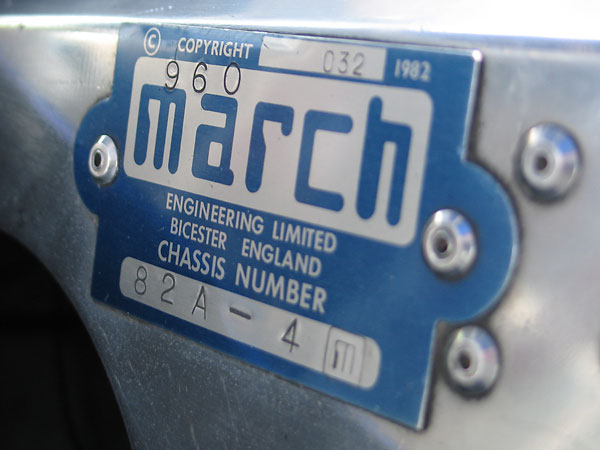
�
MARCH Engineering Limited, Bicester England
�
Chassis Number 82A - 4 (M)
�
copyright 1982 (960 - 032) - 1982
�
Justin Frick's March 82A / 822
��
Between 1994 and 1996, Alan Hine of Michigan made a lot of progress with restoring 82A-4�
to 822 specification. Specifically, he sourced and installed a BMW M12/7 2.0L engine and�
he commissioned Preform Resources to fabricate authentic lightweight composite bodywork.�
Largely complete but unpainted and unsorted, Justin Frick purchased 82A-4 from Alan Hine�
in January 2008.�
�
�
Justin stripped the car back down to a tub and a pile of nuts and bolts, and did a�
complete rebuild. It had been stored in a damp garage, so there were some corrosion issues.�
Leveraging the resources of his father's automotive restoration shop, Europa Macchina of Lewisbury�
Pennsylvania, Justin brought the car up to the stunning standard of presentation shown here.�
Justin reports: "The fit of the body was excellent, but it was built to be VERY lightweight�
so we found it a little tough to work with."�
�
BritishRacecar photographed Justin's 82A/822 on its initial shake-down weekend. Since that time,�
he has dialed the car in quite a bit. The biggest change Justin made was installation of more�
aggressive wings, both front and rear. The new wings were shaped to match original wings from a�
March 832. Their chord widths and their mounting locations are unchanged from what were on the�
car when he purchased it, but the new wings provide appreciably more downforce. �
�
�
�
Want to see more articles like this? BritishRaceCar.com is funded by readers like YOU.
�
To contribute to our operating fund, PLEASE click here and follow the instructions.
�
(Suggested contribution is twenty-five bucks per year. Feel free to give more!)
�
�
�
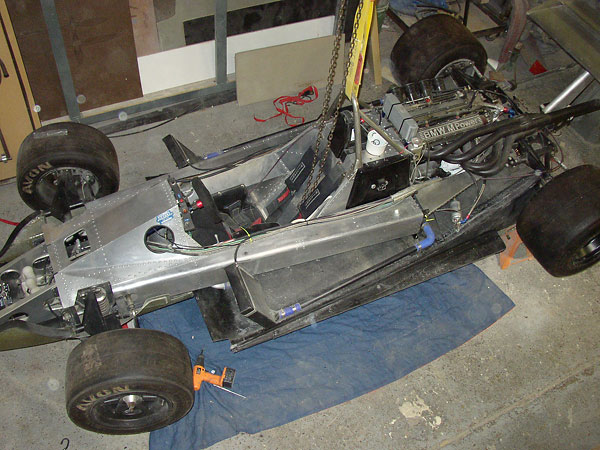
�
Dave Craddock of Preform Resources in Detroit Michigan completely rebuilt the car's bodywork and
�
aerodynamic package. The March 822 features a full ground effects undertray to create a very
�
large amount of aerodynamic downforce at speed.
�
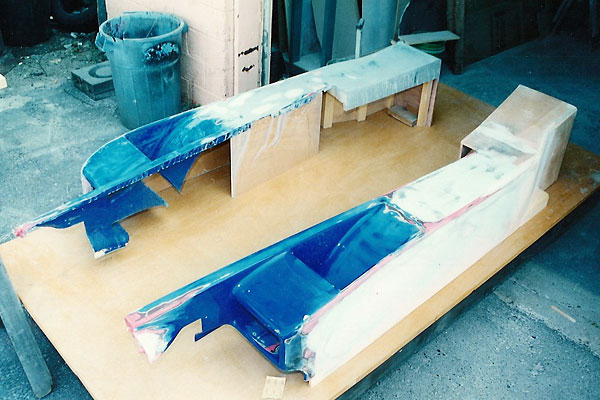
�
When Alan Hine purchased this car, it came with old Formula Atlantic spec side pods. Preform
�
Resources didn't just recreate them: they extended the side pods to Formula Two length.
�
The new bodywork is composed of carbon fiber and E-glass, with epoxy resin.
�
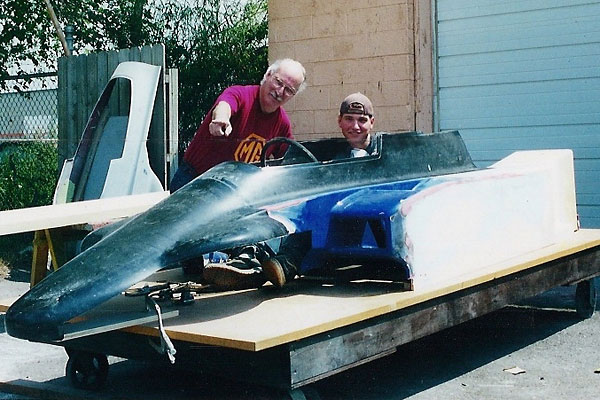
�
Entirely new nose and cockpit sections, made from carbon fiber.
�
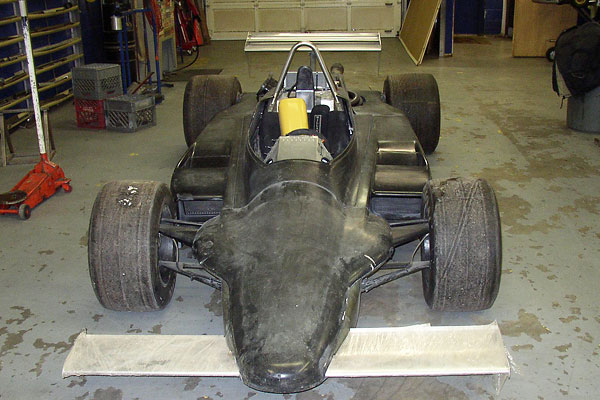
�
Body fabrication completed, the car was delivered it to Averill Racing for mechanical work.
�
Please support the sponsoring companies who make www.BritishRaceCar.com possible, including:
� �
 �
�
�
�
Features and Specifications
�| Engine: | �BMW M12/7 2.0L four-cylinder.�
Grey cast iron cylinder block.�
Forged, single plane crankshaft.�
Cast aluminum alloy cylinder head.�
Dual overhead camshafts.�
Four valves per cylinder.�
Bosch mechanical fuel injection system.�
Kugelfisher pump.�
BMW slide throttle manifold (part number 1304008).�
Bosch breakerless electronic ignition system.�
Magnecor Electrosports 70 spark plug wires.�
Dry sump lubrication system. | �
| Cooling: | �dual copper/brass radiators, mounted in side pods.�
Custom fabricated aluminum header tank.�
Mocal aluminum 19-row 235mm oil cooler. | �
| Exhaust: | �custom four into one header. | �
| Transaxle: | �Hewland FT200 5-speed (serial number 1537).�
Limited slip differential.�
March bellhousing with integral engine oil reservoir built in.�
CV joints on inner, u-joints on outer. | �
| Front Susp.: | �rocker arm actuated KONI double adjustable shock absorbers.�
Eibach 900#/inch springs.�
Adjustable antisway bar. | �
| Rear Susp.: | �rocker arm actuated KONI double adjustable shock absorbers.�
Eibach 1200#/inch springs. �
Driver-adjustable blade-type antisway bar. | �
| Brakes: | �(master) dual Girling master cylinders with cockpit-adjustable bias bar. � (front) Lockheed CP2361 4-pot aluminum calipers and vented rotors, mounted outboard. � (rear) Lockheed CP2361 4-pot aluminum calipers and vented rotors, mounted outboard. | �
| Wheels/Tires: | �Jongbloed Racing wheels, featuring cast magnesium centers and aluminum rims.�
Avon bias-ply tires (9.0/20.0/13 front and 13.0/23.0/13 rear). | �
| Electrical: | �electric starter.�
Xtreme AGM Permaseal battery.�
Bosch alternator. | �
| Instruments: | �(left to right) �
Racetech dual oil pressure (0-100psi) and oil temperature (40-140C) gauge,�
Stack electronic tachometer (0-10500rpm), and�
Racetech dual fuel pressure (0-100psi) and water temperature (30-110C) gauge. | �
| Fuel System: | �ATL fuel cell. | �
| Safety Eqmt: | �SPA/Lifeline fire suppression system.�
Schroth 6-point safety harness. (Willans shoulder pads.)�
Momo MOD.27c steering wheel mounted on a Bicknell Racing Products quick-release hub. | �
| Weight: | �1195#, wet. | �
| Racing Class: | �Formula Two | �
Engine Installation
��
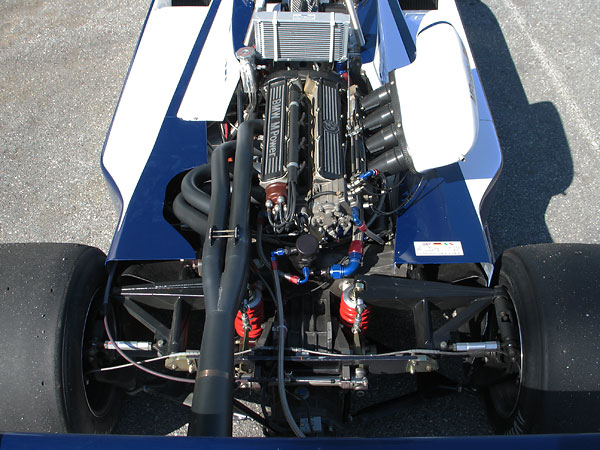
�
Corrado Fabi won the 1982 Formula Two World Championship with a BMW powered March 822. He
�
finished first in five of the 13 races. Teammate Johnny Cecotto won three of the remaining races.
�
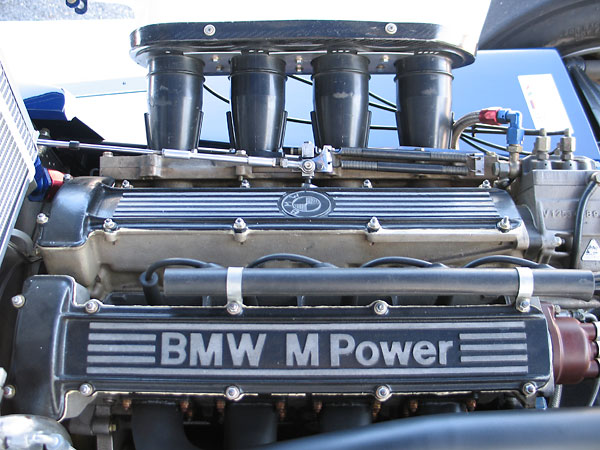
�
The BMW engine powered drivers to six Formula Two world championships between 1973 and 1982.
�
(Five in Marchs.) Through that era, BMW powered cars achieved 67 wins in 142 championship
�
races. By the end of 1982, the BMW M12/7 engine produced 320bhp at 10,000rpm.
�
In 1984, BMW left Formula Two racing to focus instead on Formula One.
�
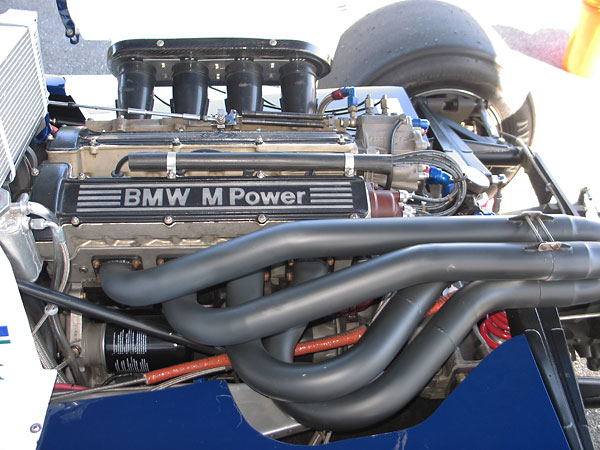
�
BMW's M12/7 Formula Two engine was remarkably similar to their contemporary Formula One engine.
�
Differences? 1999cc displacement (89.2mm bore, 80mm stroke) versus 1449cc (89.2mm bore, 60mm
�
stroke), normally aspirated instead of turbocharged, and mechanical fuel injection instead of digital
�
electronic fuel injection. At ~1.9 bar boost, the F1 engine produced over 650hp at 9500rpm.
�

�
Custom fabricated four-into-one exhaust header.
�
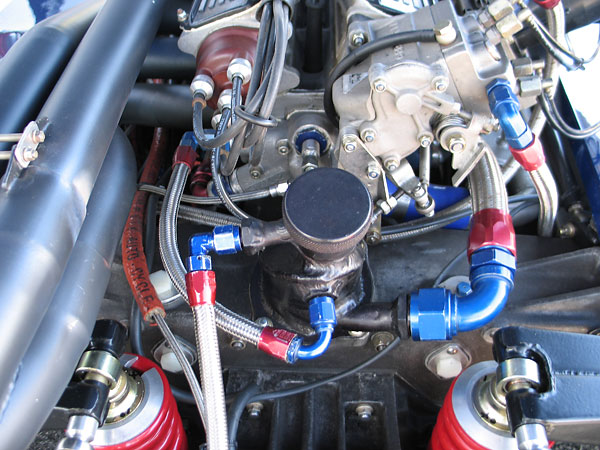
�
Foreground: to save space, March built the engine oil reservoir right into the bellhousing.
�
Background: Bosch breakerless electronic ignition. Magnecor Electrosports 70 spark plug wires.
�
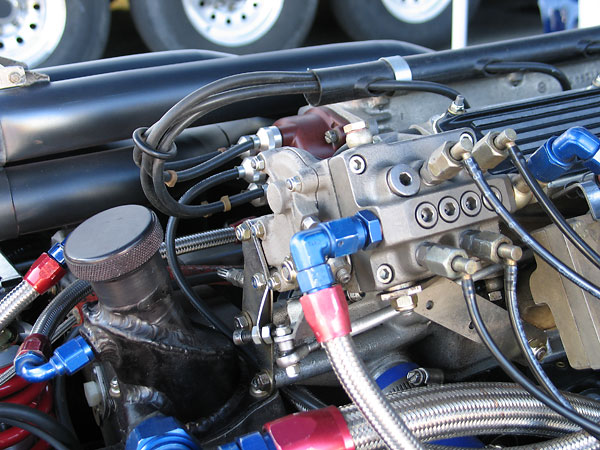
�
The Bosch mechanical fuel injection system is built around a Kugelfisher pump.
�
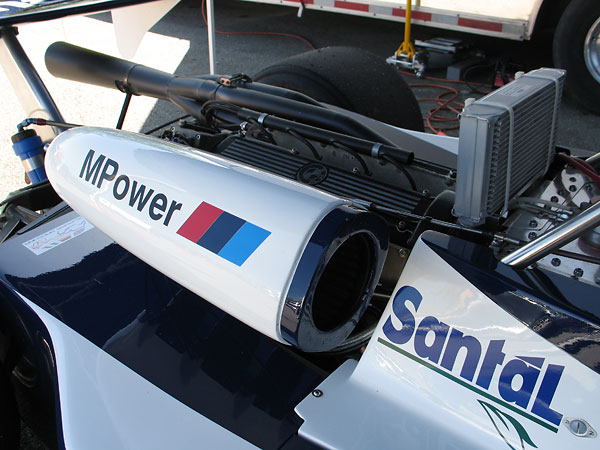
�
This engine has been rebuilt by Hank Clarkson, of Clarkson Engineering in Lehighton, PA.
�
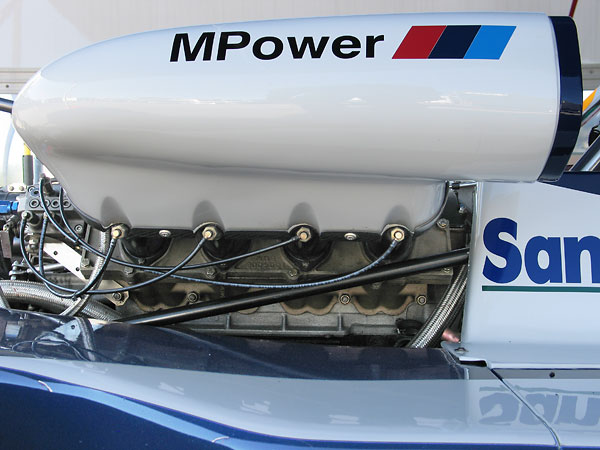
�
BMW slide throttle manifold (part number 1304008). Note that the fuel injectors are mounted in
�
the induction trumpets, upstream from the throttle blades. Spacing the injectors further out
�
generally promotes high end power at the expense of low end torque.
�
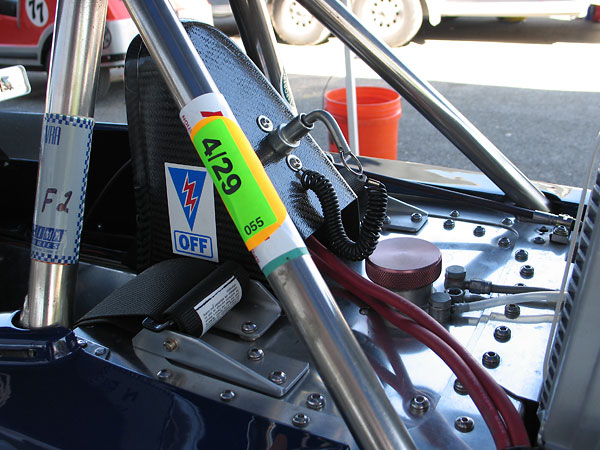
�
ATL fuel cell, mounted between driver and engine.
�
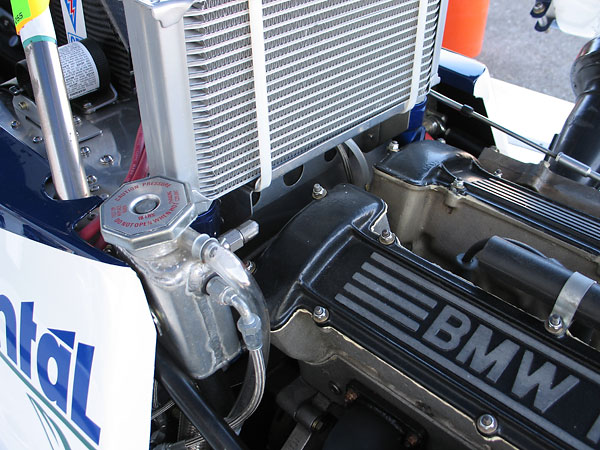
�
Custom fabricated aluminum header tank. Mocal aluminum 19-row 235mm oil cooler.
�
�
Front Suspension, etc.
��
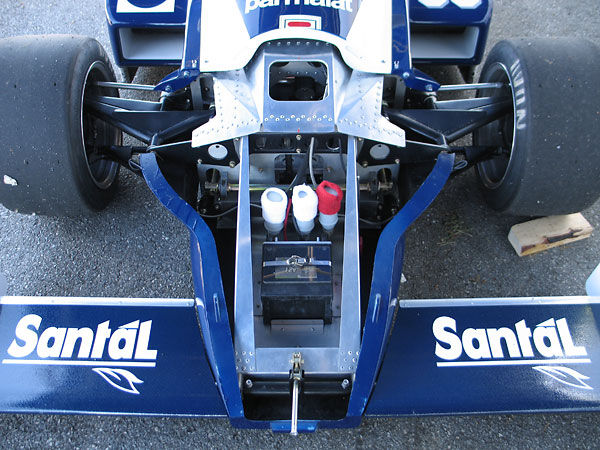
�
In most respects, the car accurately reflects the features and specifications of Formula Two
�
racecars of its era. One exception is shown here: a larger and heavier battery has been
�
installed for vintage racing. Back in the day, Formula Two racecars used air starters.
�
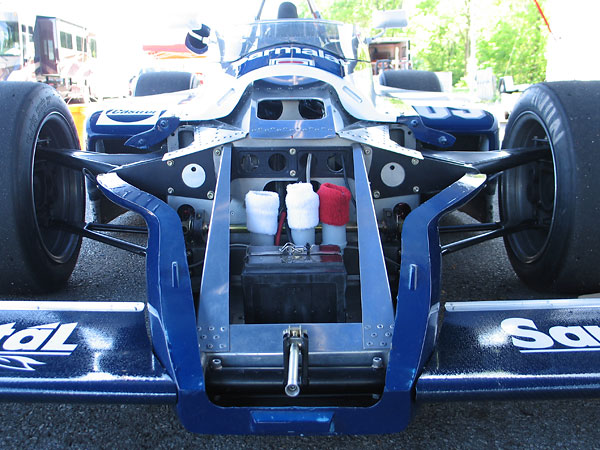
�
Inboard mounted shock absorbers helped clear the path of airflow to the radiators.
�
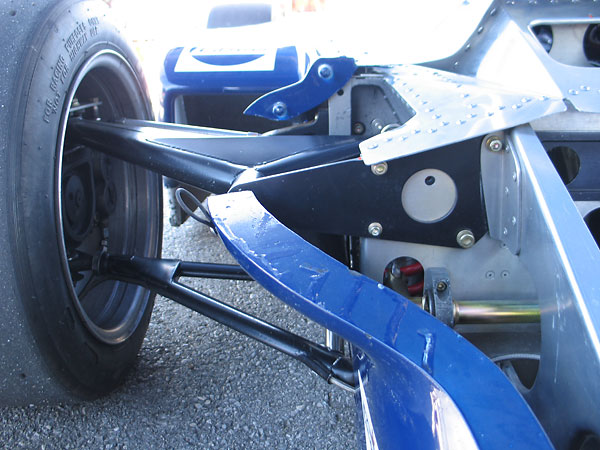
�
Lockheed CP2361 4-pot aluminum calipers and vented rotors, tucked deeply into the wheels.
�
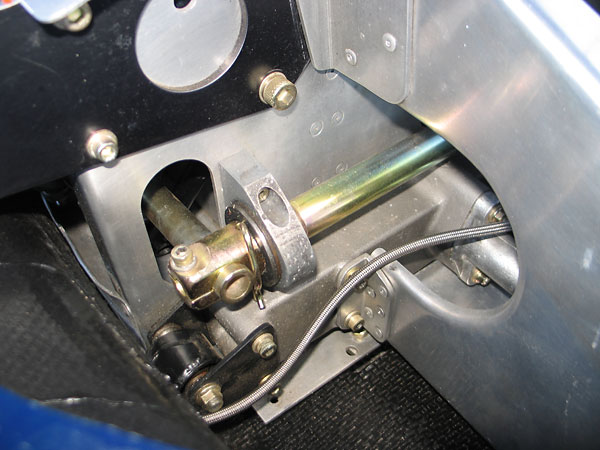
�
The front anti-sway bar can be adjusted by loosening the pinch bolt and extending or
�
retracting the lever. Obviously, the car has to be parked to make this adjustment.
�
The proportion of front-to-rear roll stiffness can be adjusted from the cockpit.
�
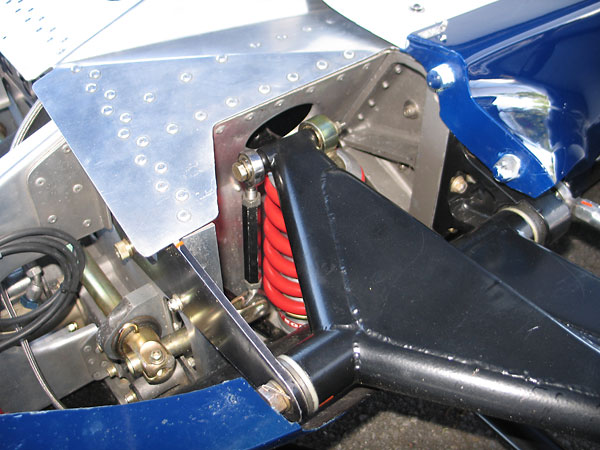
�
Phil Harris of Truechoice installed internal spacers to shorten the stroke of these KONI shocks.
�
Deliberate restriction of droop travel - "droop limiting" - is a chassis set-up technique that probably
�
originated on Reynard Formula Ford 2000 racecars in 1989. It only took about two years for droop
�
limiting to become standard practice in most of the fast Formula car classes. Soon, constructors
�
began designing new front suspensions with little or no droop travel.
�
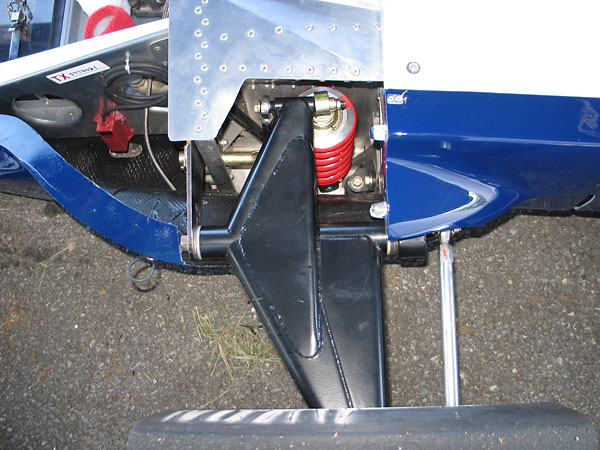
�
The problem: as "wings-and-slicks" cars grew progressively faster, racers were having persistant
�
problems with understeer from mid-corner to corner-exit. Biasing aerodynamic downforce toward
�
the front was an inadequate solution because results varied greatly with speed. High wheel rates
�
seemed to complicate matters. Some racers tried raising rear ride height (i.e. increasing rake),
�
but that tended to goof up brake balance and it also compromised the performance of ground
�
effects systems. Racers needed a way to increase front grip mechanically.
�
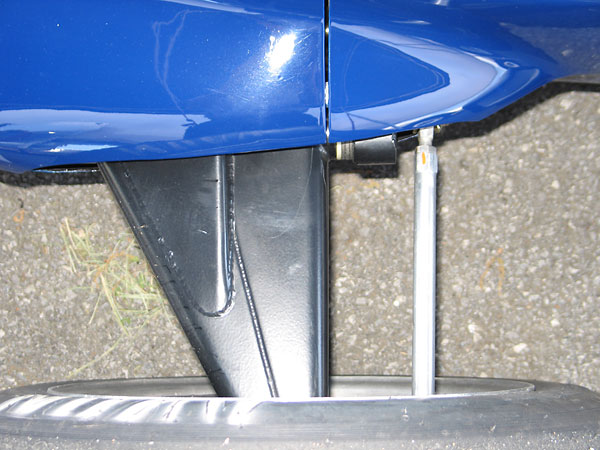
�
Droop limiting the front suspension helps reduce corner exit understeer through the following process:
�
(a) while turning, the chassis rolls far enough to engage a mechanical stop (i.e. a droop limiter), (b) as
�
an immediate result, the front suspension's roll center shifts to the inside tire's contact patch, and (c)
�
geometric roll resistance increases sharply. Meanwhile, the throttle has been mashed so weight is
�
transferring to the rear tires and the car is rapidly accelerating forward. Justin says droop limiting
�
gave him more front-end grip in both low-speed and high-speed corners, and allowed him to adjust
�
his front anti-sway bar to a softer setting.
�
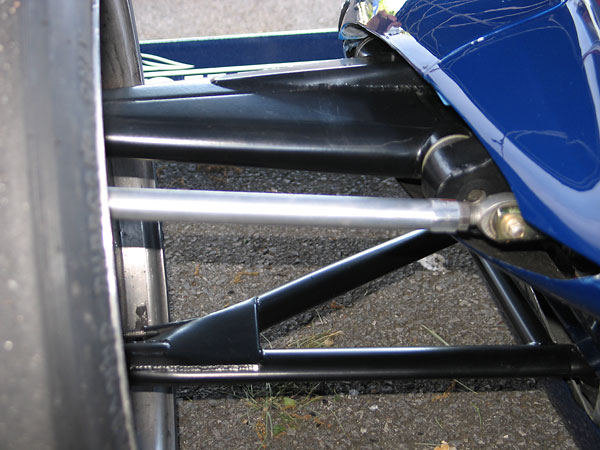
�
Cars that generate a lot of aerodynamic downforce at speed require stiffer suspension springs.
�
The wheel rates on Justin's 1195# March 822 are ~800 #/inch (front) and ~950 #/inch (rear)!
�
Justin reports that the car feels VERY stiff until you get it up to speed. Once there, the
�
suspension actually works over a larger range of motion than he expected.
�
�
�
�
Want to see more articles like this? BritishRaceCar.com is funded by readers like YOU.
�
To contribute to our operating fund, PLEASE click here and follow the instructions.
�
(Suggested contribution is twenty-five bucks per year. Feel free to give more!)
�
Rear Suspension
��
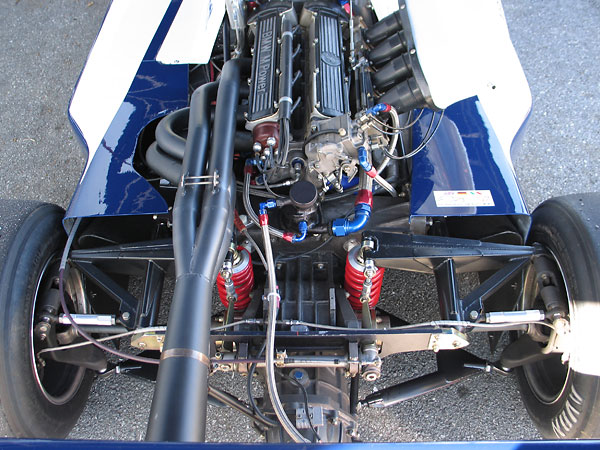
�
Rocker arm actuated rear suspension.
�
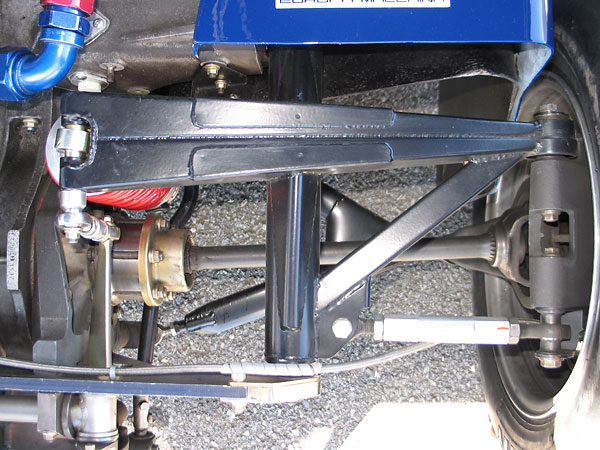
�
Relocating coilover rear shock absorbers inboard helped to clear the way for ground effects tunnels.
�
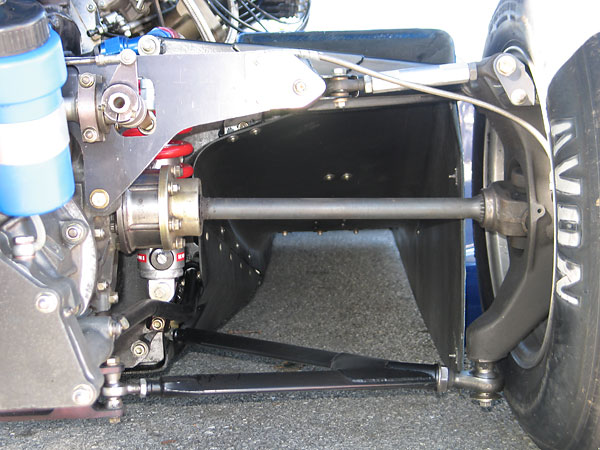
�
Lockheed CP2361 4-pot aluminum calipers and vented rotors, mounted inside the rear wheels.
�
With shock absorbers moved inboard, brakes had be located elsewhere.
�
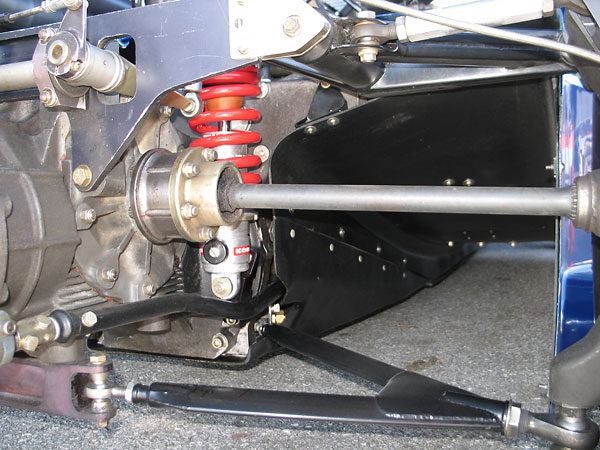
�
Halfshafts: CV joints on inner ends and u-joints on outer ends.
�
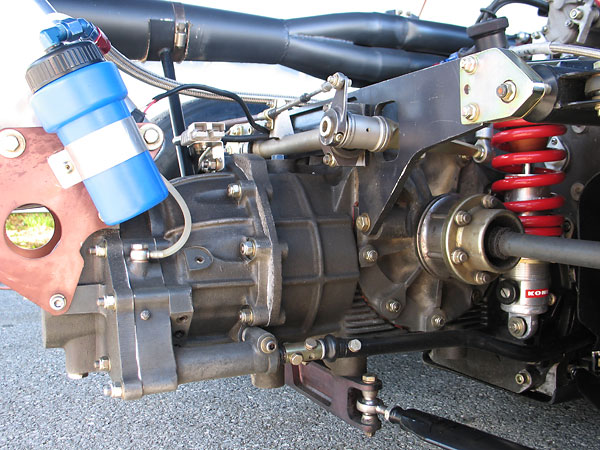
�
Hewland FT200 5-speed (serial number 1537) with limited slip differential.
�
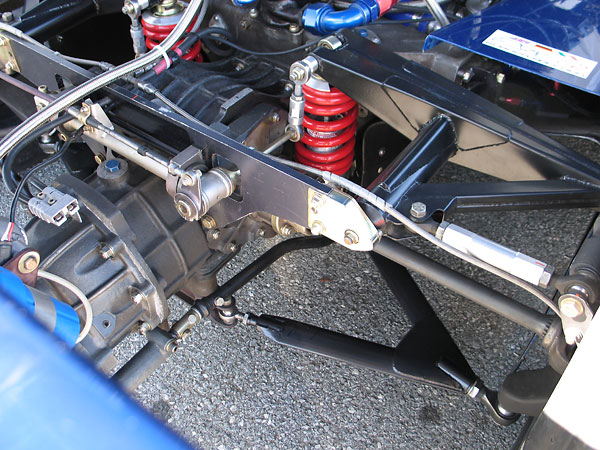
�
Lower wishbones constructed of airfoil tubing.
�
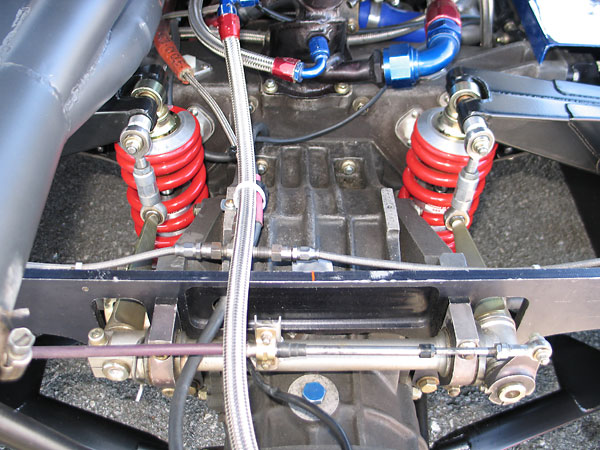
�
Blade type anti-sway bar with cable adjuster.
�
�
Interior
��
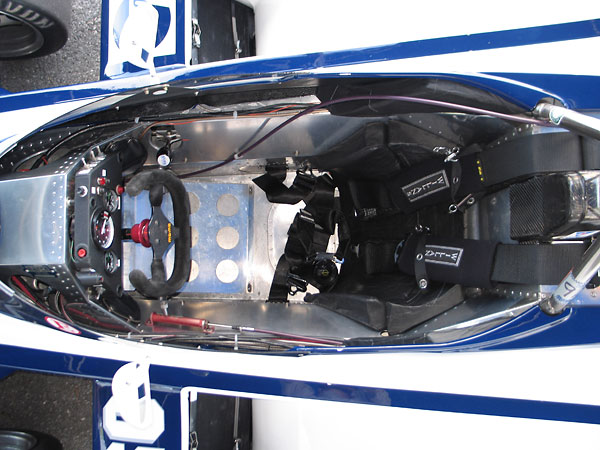
�
The bottom seat cushion has been removed to accommodate Justin's height.
�
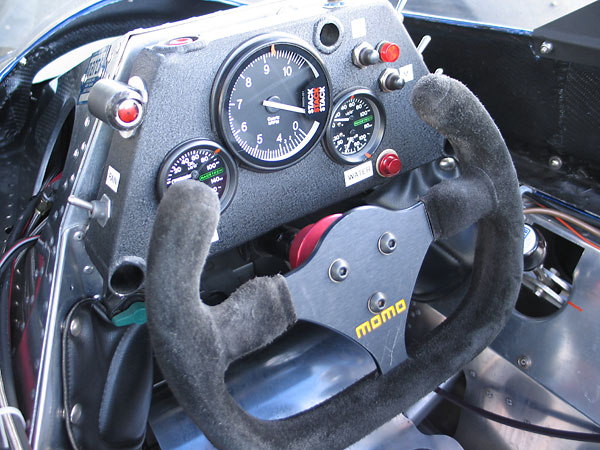
�
Cable-driven tachometers were standard issue for racecars in the early eighties. "Noisy" ignition
�
systems would have made that era's electronic tachs behave eratically.² This modern Stack
�
electronic (0-10500rpm) tachometer has a retro appearance, but offers electronic peak RPM
�
tell-tale memory, a shift-light, a "fast lap" feature, etc. The push-button labeled "M" is for
�
accessing Max and Lap Marker features. The "R" button is for Run and Reset features.
�
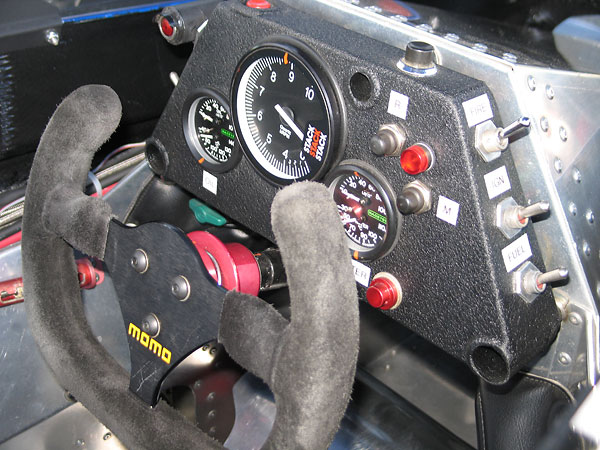
�
Left: Racetech dual oil pressure (0-100psi) and oil temperature (40-140C) gauge.
�
Right: Racetech dual fuel pressure (0-100psi) and water temperature (30-110C) gauge.
�
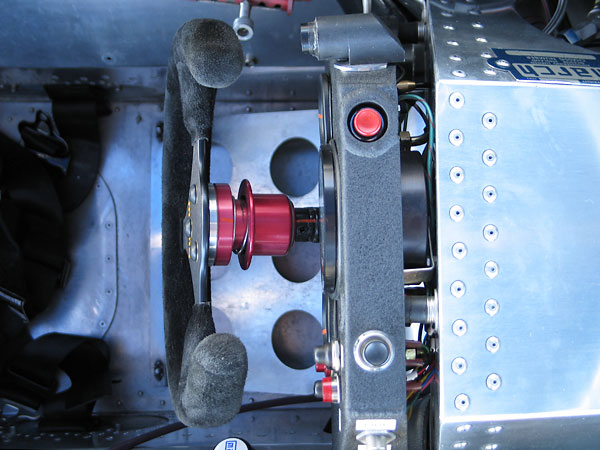
�
Momo MOD.27c steering wheel mounted on a Bicknell Racing Products quick-release hub.
�
Recessed red button to activate fire suppression system. Black button for starter.
�
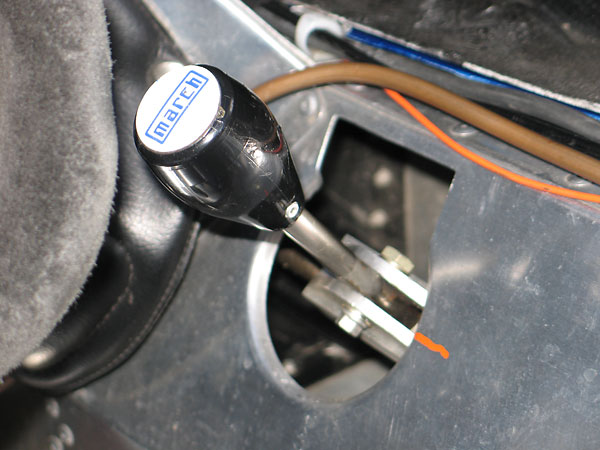
�
Gear selector mechanism.
�
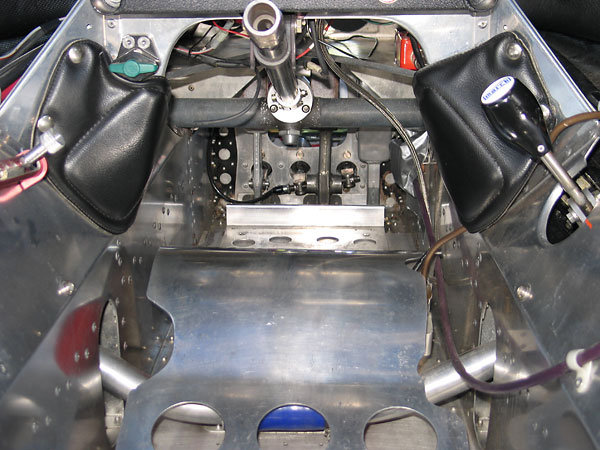
�
Green knob for front/rear brake bias adjustment.
�
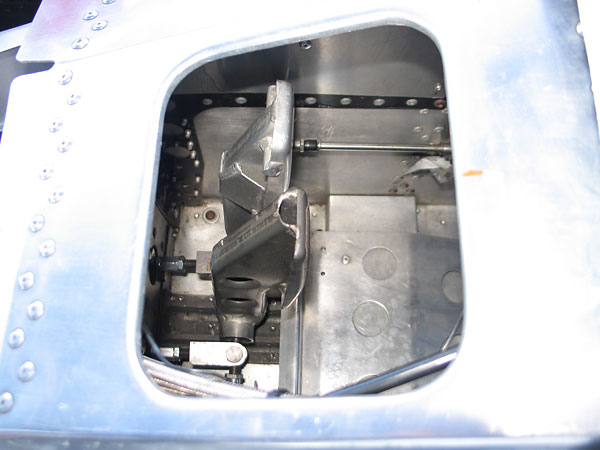
�
Pedal fabrication details.
�
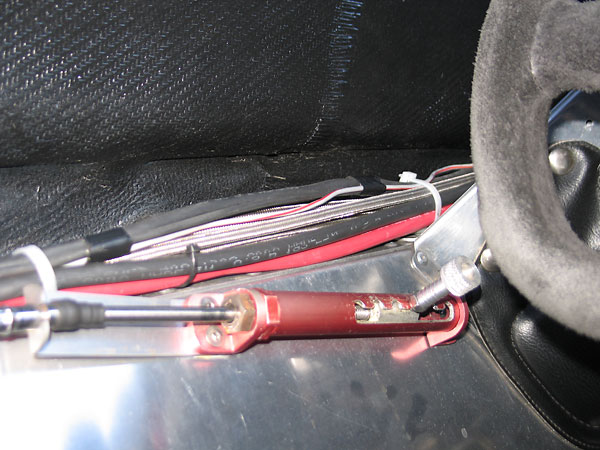
�
Rear anti-sway bar adjuster.
�
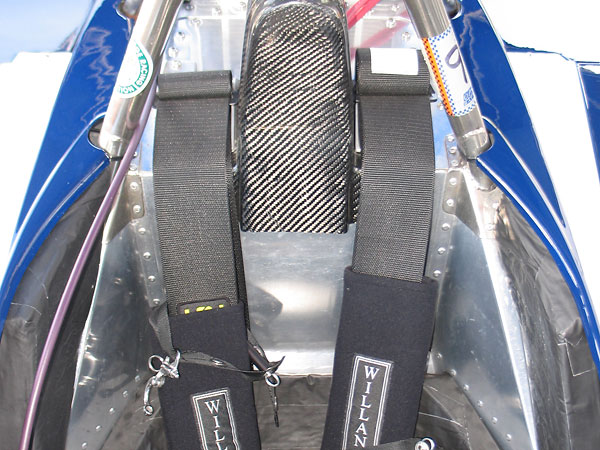
�
Schroth 6-point safety harness fitted with Willans shoulder pads. Shoulder strap attachment points
�
have been moved from the rear bulkhead up to above the fuel cell to accommodate Justin's height.
�
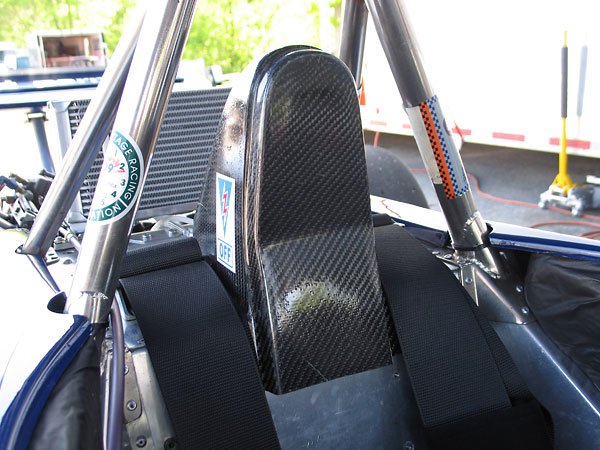
�
Carbon fiber headrest? Carbon fiber was just coming into use on Formula Two cars in 1982.
�
March switched from aluminum monocoque to carbon composite tubs for Formula Two in 1984.
�
Robin Herd explained that carbon tubs were more durable, and that the torsional rigidity of
�
aluminum monocoque tubs begins dropping appreciably before the end of one season of racing.
�
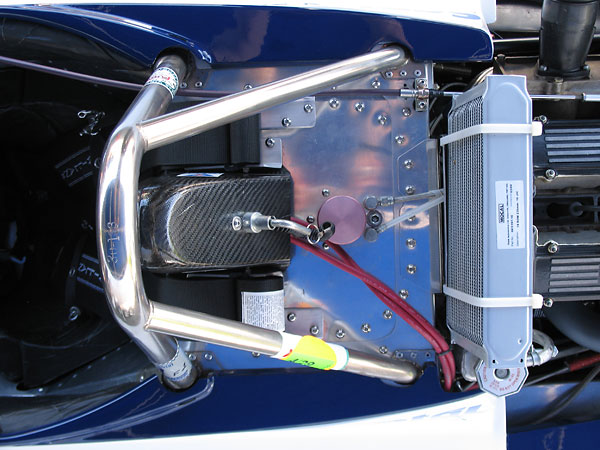
�
Engine kill switch is mounted inside the headrest.
�
�
Exterior
��
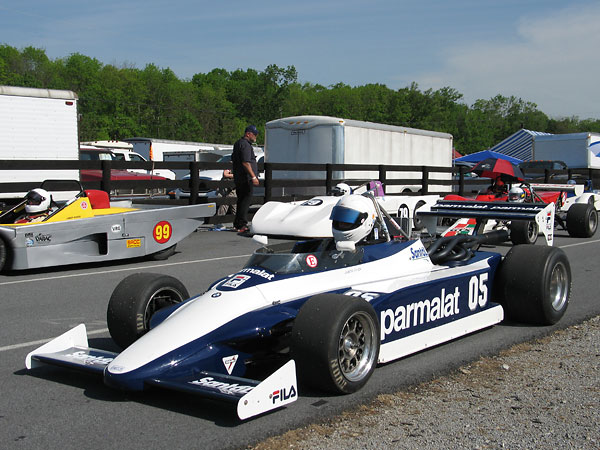
�
We photographed Justin's March 822 at Summit Point Motorsports Park during Vintage Racer Group's
�
2010 Jefferson 500. This was the quickest car participating by a margin of over 1.8 seconds per lap.
�
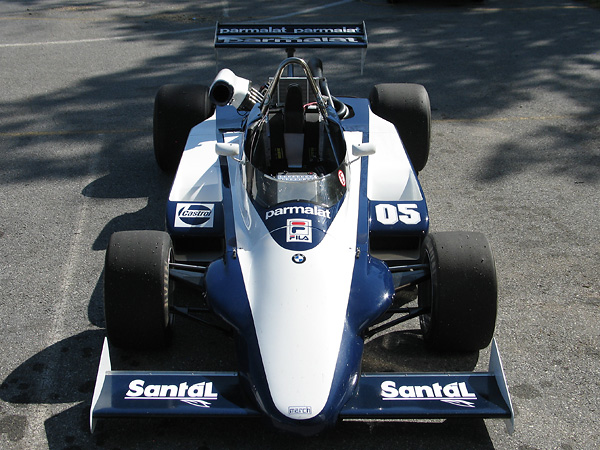
�
Justin won Saturday afternoon's Charlie Gibson Trophy sprint race by a 23.579 second margin.
�
His best lap was timed at 1:14.58, which averages out to a stunning 94.65 miles per hour
�
around that tight and technically challenging 2.0 mile circuit.
�
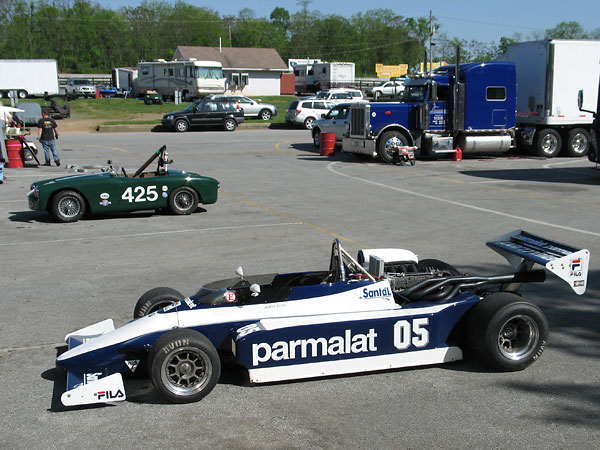
�
In September 2011, we saw Justin drive his March 822 at Watkins Glen. On that occasion, Justin
�
circled the 3.4 mile Watkins Glen circuit at 1:51.337, which works out to 109.94 miles per hour!
�
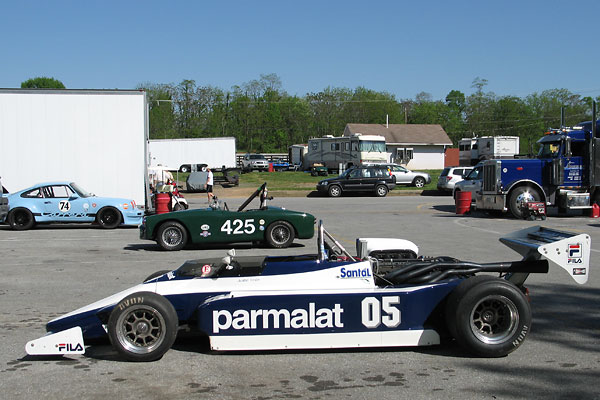
�
Justin Frick chose Parmalat livery because this 1982 model Formula Two racecar features a BMW M12
�
engine. Similarly liveried Brabham-BMW cars were competitive in Formula One throughout 1982. In
�
Formula One trim, the BMW engine was turbocharged. March-Ford racecars were entered in fifteen
�
of the Formula One championship's sixteen rounds, but failed to score any championship points.
�
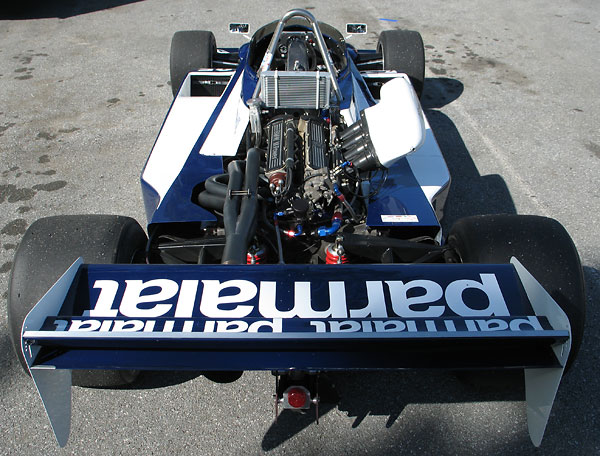
�
Parmalat was an Italian food company that mastered ultra high temperature pasteurization techniques.
�
They leveraged the technology to become one of the world's leading suppliers of dairy and fruit juice
�
products. UHT processing gives milk a stable shelf life of six to nine months, at the expense of flavor.
�
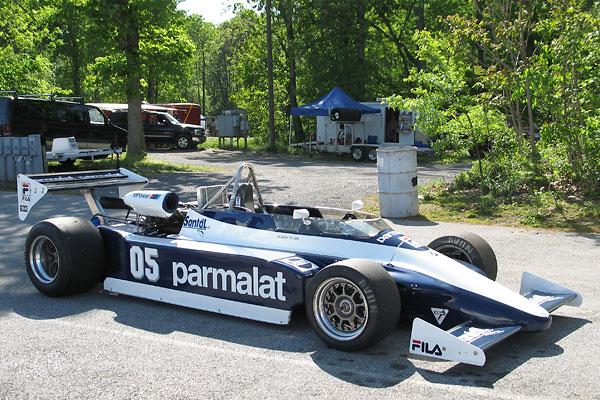
�
Parmalat became a worldwide brand when Bernie Ecclestone recruited the company to sponsor the
�
Brabham Formula One team for the 1978 season. Parmalat's funding made it possible for Ecclestone
�
to woo defending Formula One World Champion Niki Lauda away from the Ferrari team.
�

�
Parmalat was Brabham's principle sponsor through five seasons, while fielding six different drivers,
�
with five different chassis designs, and with three engine suppliers. In 1982, Nelson Piquet and
�
Riccardo Patrese drove 1.5L turbocharged BMW powered Brabham BT50 racecars in fourteen and ten
�
championship series races, respectively. Piquet won the Canadian Grand Prix and Patrese won at
�
Monoco. With a Brabham-BMW, Piquet won the 1983 championship - but Parmalat had moved on.
�
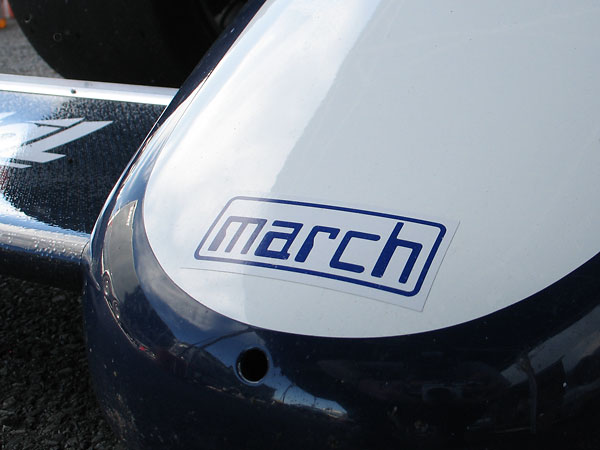
�
March decal. On the wings: Santál is the tradename that Parmalat uses for marketing
�
a diverse range of fruit juice products. The Santál brand was launched in 1980.
�
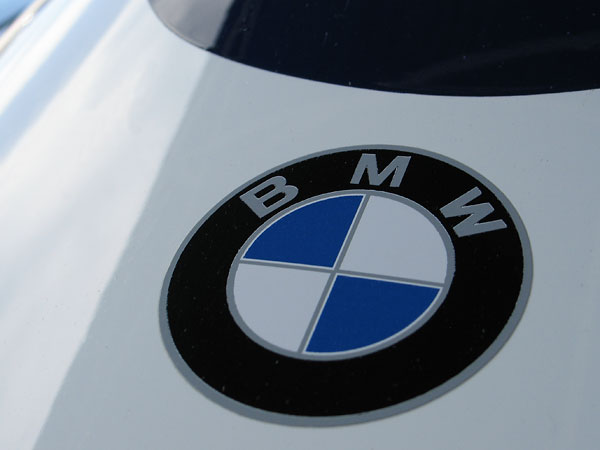
�
BMW decal, because this racecar is powered by a BMW M12/7 2.0L four-cylinder engine.
�
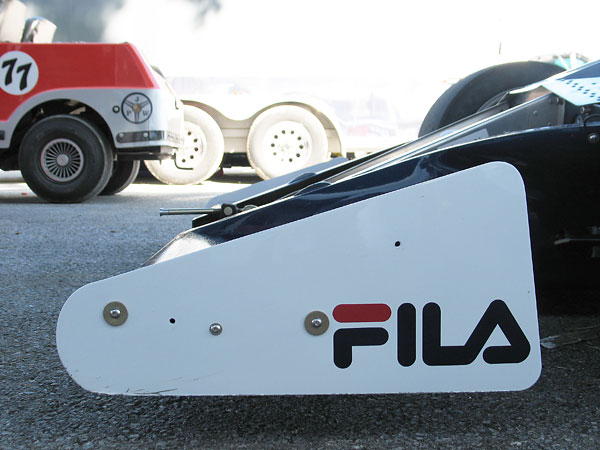
�
Founded in Italy in 1911, Fila is a leading global supplier of designer tennis and sports clothing.
�
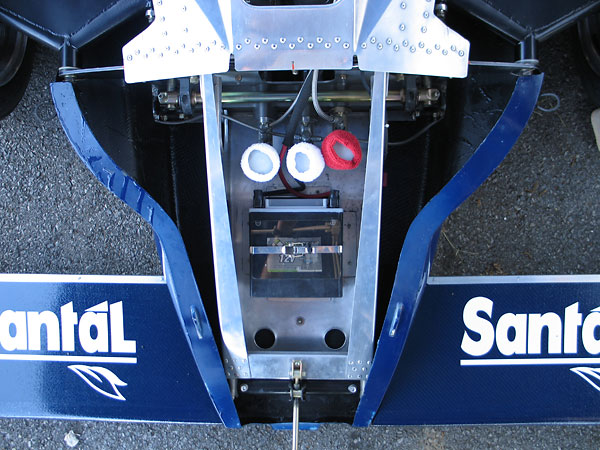
�
Xtreme AGM Permaseal battery. Absorbed glass mat batteries are sealed except for a pressure relief valve,
�
so they can be mounted at any angle and they rarely leak acid. Compared to flooded lead acid batteries,
�
AGM batteries recharge relatively slowly and are less capable of withstanding high temperatures.
�
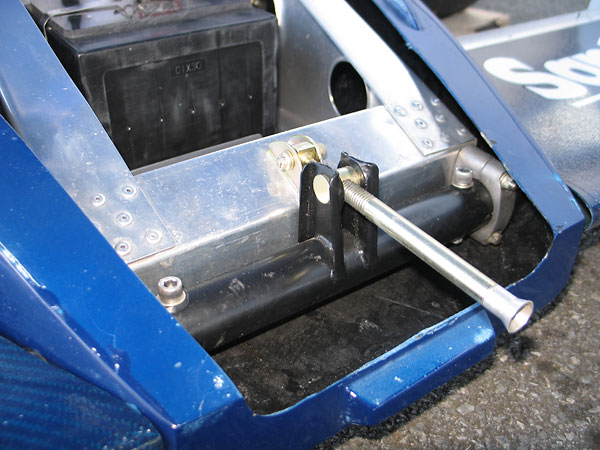
�
Wing angle adjuster mechanism.
�
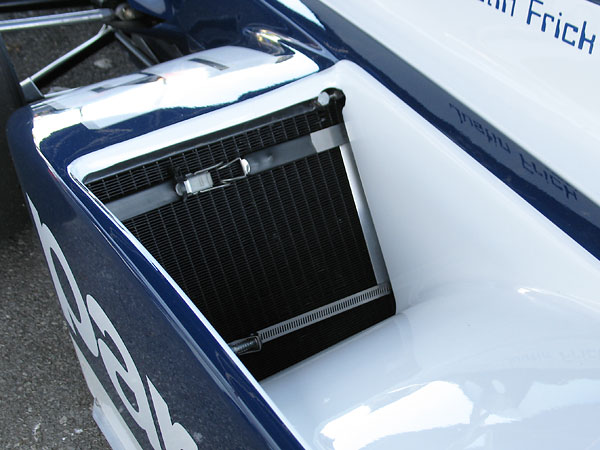
�
The March 822 features dual copper/brass radiators, mounted in its side pods.
�
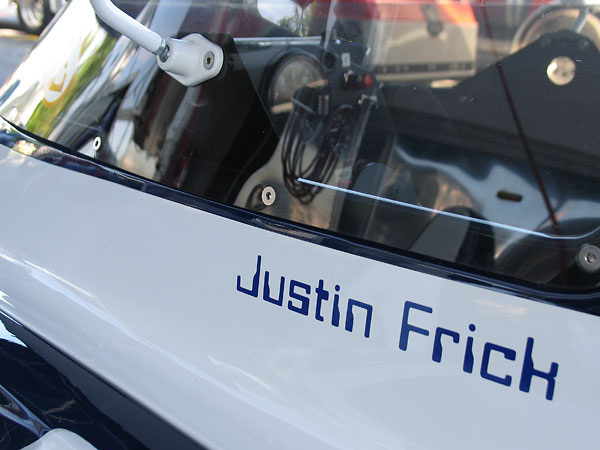
�
Justin Frick. (This typeface is called "NASA", and it matches the March logo.)
�
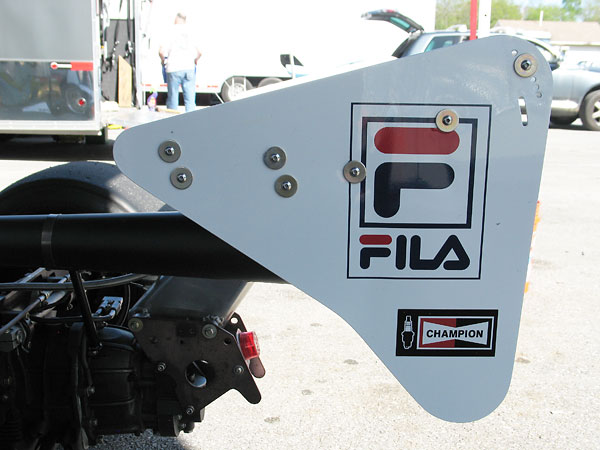
�
Rear wing endplate detail, including rake adjustment feature.
�
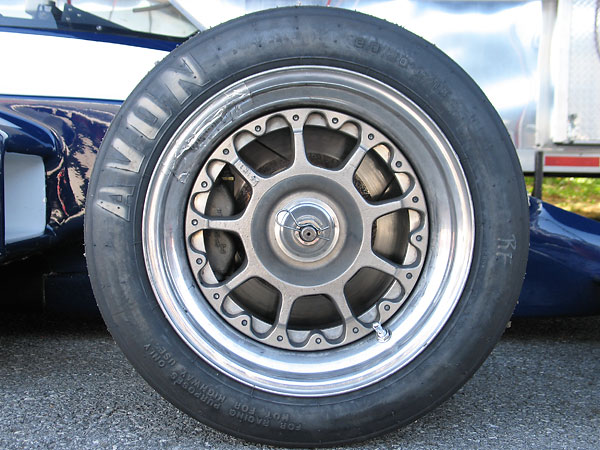
�
These American made Jongbloed Racing wheels feature cast magnesium centers and aluminum rims.
�
The March 822 originally rolled on one-piece diecast magnesium wheels, made in England by Dymag.
�
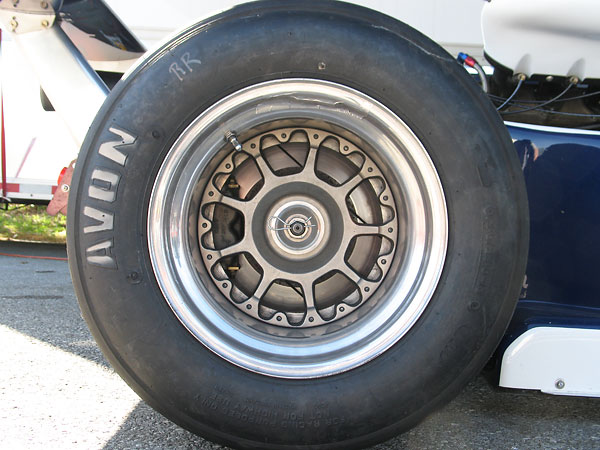
�
Avon 9.0/20.0 (front) and 13.0/23.0 (rear) bias-ply racing slicks. When this car was built in 1982,
�
Formula Two cars raced on radial tires. Bias ply tires are more popular for vintage Formula Two
�
cars because they're more driver friendly and because they warm up quicker.
�
| Notes: | ||
| (1) | �
It would be malpractice not to mention that March Engineering turned its attention�
to Indianapolis 500 racing in 1980, and that they would come to dominate that form�
of racing in the mid-1980s. In 1981, March provided 17 of 33 cars on the Indy 500�
starting grid. March racecars won the Indy 500 every year from 1983 through 1987.�
We might consider featuring a March Indy 500 car on this website if you will �
kindly make a voluntary contribution to our modest little operating fund.�
Every single dollar helps.�
� | |
| (2) | �
Ignition systems and brush-type motors inevitably produce radio frequency interence�
(RFI) and electro-magnetic interference (EMI), also known as "noise". Newer electronic�
devices are typically less sensitive to and also better shielded from RFI and EMI issues. �
� | |
�
| �
�  � (Hans Stuck's March 741, as photographed by Curtis Jacobson for BritishRacecar.com) � Did you enjoy this article? We currently have eighty more in process, featuring about 6000 new photos. � But it takes a lot of time and expense to turn photos into articles, and to publish them on the internet. � Please consider making a contribution. Your donation will help us publish more and better articles! � While you're at it, tell us which racecars interest you most. We value the opinions of our funders. � � |
�
Except where explicitly noted otherwise, all photos shown here are from April 2010 when we viewed Justin's�
car at VRG's Jefferson 500 at Summit Point Motorsports Park, West Virginia.�
Photos by Curtis Jacobson for BritishRaceCar.com, copyright 2012. All rights reserved.�
The four photos of this car's bodywork being restored are from Dave Craddock's personal collection and�
are used here by exclusive permission. Copyright 2012. All rights reserved.
�
| If you liked this article, you'll probably also enjoy these: | �|||||
 | �
Michael Snowdon '72 GRD 272 | �
 | �
Phil Mauger '73 McLaren M23 | �
 | �
Walter Davies '78 Lola T492 | �
| You're invited to discuss anything you've seen here on The British Racecar Motorsports Forum! | �|||||
�
Notice: all the articles and almost all the photos on BritishRacecar.com are by Curtis Jacobson.
�
(Photos that aren't by Curtis are explicitly credited.) Reproduction without prior written permission is prohibited.
�
Contact us to purchase images or reproduction permission. Higher resolution images are optionally available.
�

 �
�